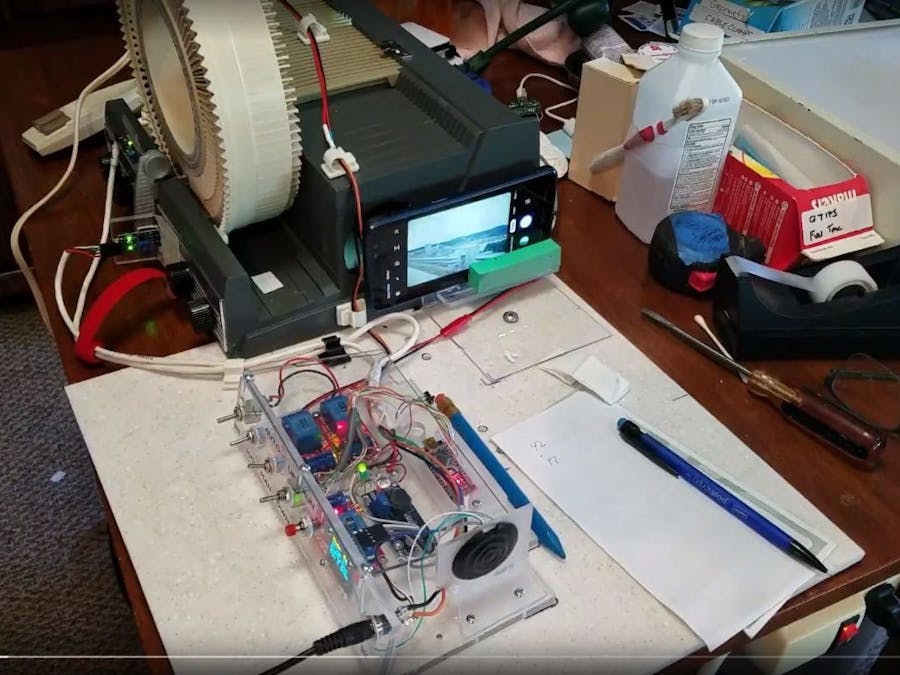I come from a large family (10 siblings) and my dad (now 90 years old) liked to use his 35mm camera.That yielded nearly 4000 slides over our childhood.We decided that these slides needed to be captured to the cloud so we would not loose them and could share among the family.We investigated copying services but feared the possibility of loosing the originals in the mail. Hey, it happened to someone in my family.Yearning to do a build with my dad (also an engineer) we set out to make the father son slide copier.
The best part of this project was collaborating with my dad. He is in the south east and I in north west. It was interesting for him to see the massive changes in technology since he retired. He started his career with tube design and ended when MSI and microprocessors (Z80) had just hit the design stage. He wasn’t up to speed on things like the Arduino but he asked really challenging questions and was a quick study. What fun!
Design ApproachWe figured handling slides was as much an art as science so rather than inventing our own feeding mechanics we decided to use a hacked slide project of the same vintage as his. We found two on eBay. I used one to gut and learn and the other as the final core of the project. It was fascinating to see how motors and mechanics were used to control this vintage machine given there were no micro-controllers available back when it was designed, but that is another story.
https://photos.app.goo.gl/vx6J5rwRuvDqy32s9
The BuildWe built a slide copy controller using a nano which controlled relays that interfaced with the projectors slide handling buttons.
A key goal was to make minimal modifications to the slide mechanics, interfacing everything from outside the unit.
- The stock incandescent bulb was replaced with a LED Brake Light array and a diffuser plate. The collumating lenses were left intact. A socket was fabricated that is a plug replacement for the incandescent bulb. We simply removed the stock bulb and bolted in the LED array and socket. https://photos.app.goo.gl/NX8xoBfqsdbqXtTG6
- The final focal lens was removed and a phone was mounted at the output of the projector using a foam frame to hold it firmly to the face of the projector. The slide is illuminated down in the projector. The phone camera is adjusted to zoom up the slide to fill its screen. https://photos.app.goo.gl/nqUwEepxxEj2GfTi9
- A controlled relay is connected to the projectors remote simulating pressing the advance button. The internal voltage of the projector is low voltage AC so we decided to isolate it with relays connected across the remotes contacts. https://photos.app.goo.gl/a9jwwyJe8Hu2rTSS7
- The controller includes switches and buttons for the operator to set tray size and copy mode as well as an OLED display to show the copiers status. See control panel. https://photos.app.goo.gl/KQn31os4U3n64HSo7
- A battery operated BT selfie shutter is used to command the phone to take a photo. A relay connects the nano to the selfie module by a simple hack across its switch contacts. https://photos.app.goo.gl/87fpHH4B4Y54Vcw66
- Two optical sensors were double back taped to the side of the projector. They detect tray presence and slide jams respectively. https://photos.app.goo.gl/hfbtAxzzyDPu3eiC7
- The controller software uses a simple state machine and display driver to control wait, automated copy, manual copy and diagnostics. You can select tray size and modify the starting slide #. The software detects a missing tray and slide jams.
- A transparent adapter is inserted and photographed between slide trays to indicate tray transitions and add tray descriptions. A slide target is used to adjust the camera's zoom. https://photos.app.goo.gl/2SQHhv6nkvKSZfUj8https://photos.app.goo.gl/jW3zzthxBQUQA1Rq5
The copier will copy slides at a rate of 825.68 slides/hr so we expect to copy all our slides in less than 8 hrs. The projects material costs were <$100.
https://photos.app.goo.gl/4A2CWqmHyqzJvx5h9
Picture Quality:
We think the picture quality after a few tweaks in your photo editor will give better than original results: https://photos.app.goo.gl/jW3zzthxBQUQA1Rq5
Build DocumentationSchematics, BOM and code available in this write-ups links
There is also a users manual included on github.
Bill of MaterialsNano: https://amzn.to/2NzsnFL
Display: https://amzn.to/2NxhFQ6
Relay Modules: https://amzn.to/2MIGFEq
Selfie module: https://amzn.to/2U8EwCE
12V to 5V power module: https://amzn.to/2MGMbav
5.5 x 2.1 mm power jack: https://amzn.to/2ZrtSbm
12V power supply: https://amzn.to/2ZtAYfy * we got ours from the local thrift store
Optical sensor modules: https://amzn.to/2MJ2SlN
We made our own Nano mount but next time I would use this: https://amzn.to/2HyEFKO
Switches & push button: scarfed from our reuse bins







Comments